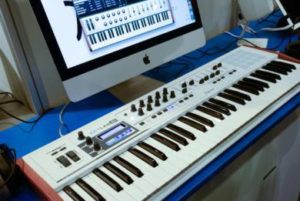One of the first things new MIDI users realize is that it is rather complex and difficult to program, perform and record MIDI with a standard QWERTY keyboard. As a result, they quickly start looking for the right MIDI keyboard. The problem here is that, for an inexperienced novice, the sheer number of various MIDI models can be overwhelming. If you are one of these, you should learn more about the main and specific features, in order to make an easier purchase.
The controllers
Start with the MIDI controllers. The majority of MIDI programming is done using a MIDI controller. The standard keyboard’s user interface is the one most musicians are perfectly comfortable using. It is well suited for performing all kinds of rhythmic patterns, as well as chordal and melodic parts.
Non- Weighted Vs. Weighted
Next up, pay attention to the keys themselves. Here, your decision should be based on whether you prefer non-weighted or weighted keyboard action. In simple words, this refers to the amount of effort required to push down a key. Synth keys, or non-weighted ones, have a very light, almost non-existent feel of the action. On the other hand, weighted action keys require much more force, in order to mimic traditional piano keys. Keep in mind that non-weighted keyboards are cheaper than weighted ones.
The size
 Moving on, take into consideration the number of keys you would like a MIDI controller to have. Standard pianos have 88 keys, but that does not mean you should necessarily purchase a controller with 88 keys. When choosing the perfect size of your keyboard, take into account a number of other factors. Are you an experienced and trained pianist? Do you have a large or small studio? If you are not a trained pianist and you have a small studio, you will not need a keyboard with 88 keys. Your best option would be a MIDI controller with 25, 27 or 61 keys. Not only are these keyboards much cheaper but they are also smaller and simpler to use.
Moving on, take into consideration the number of keys you would like a MIDI controller to have. Standard pianos have 88 keys, but that does not mean you should necessarily purchase a controller with 88 keys. When choosing the perfect size of your keyboard, take into account a number of other factors. Are you an experienced and trained pianist? Do you have a large or small studio? If you are not a trained pianist and you have a small studio, you will not need a keyboard with 88 keys. Your best option would be a MIDI controller with 25, 27 or 61 keys. Not only are these keyboards much cheaper but they are also smaller and simpler to use.
MIDI or USB
These days, the majority of modern MIDI keyboards can be connected to your computer via USB. This makes the entire setup process much easier and quicker. In most cases, the moment you plug in the keyboard, your computer will instantly recognize it. If your computer fails to recognize the keyboard, what you should do is add it to your custom MIDI configuration in the MIDI setup section of your computer’s preferences menu.
When looking to make a purchase, keep in mind that there are a number of MIDI models on the market that you cannot connect via USB. These models feature only MIDI ports, and they are designed so as to connect directly to a MIDI interface. It is this interface that you subsequently connect to your computer via USB. These keyboard types are meant to be used alongside considerably larger MIDI configurations. Therefore, if you have no need for them, make sure to avoid them and go with standard USB ones.

Additional features
Lastly, pay attention to some of the additional features most MIDI keyboards are known to have. The following are the most common ones.
- Faders
These can be used to control the amount of reverb, volume, and other software parameters.
- Knobs
The majority of keyboards have knobs which are used to change parameters such as track and pan volume.
- Pads
These can be used to add drums as well as other rhythmic parts.

